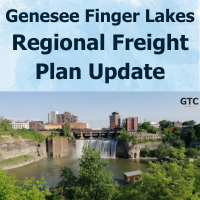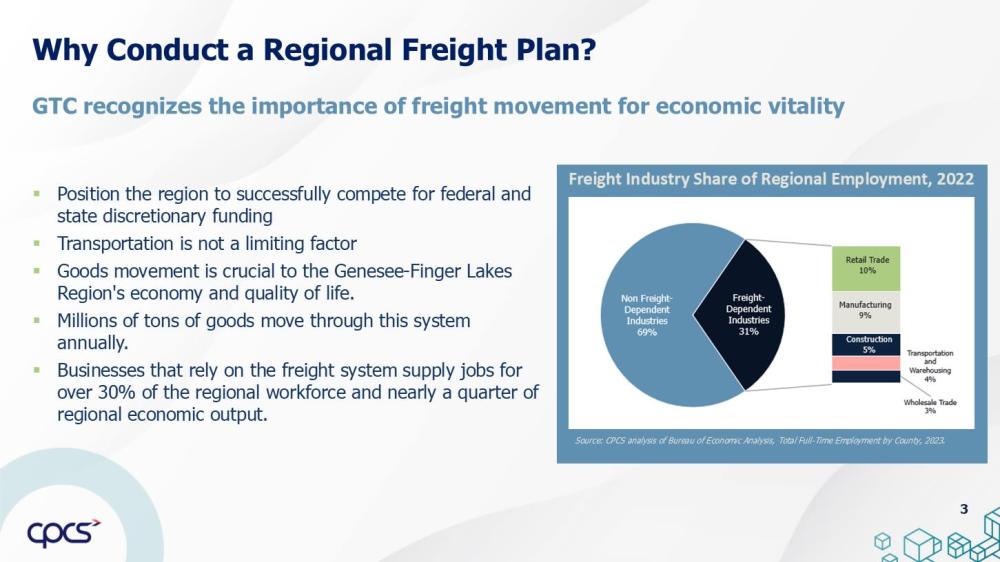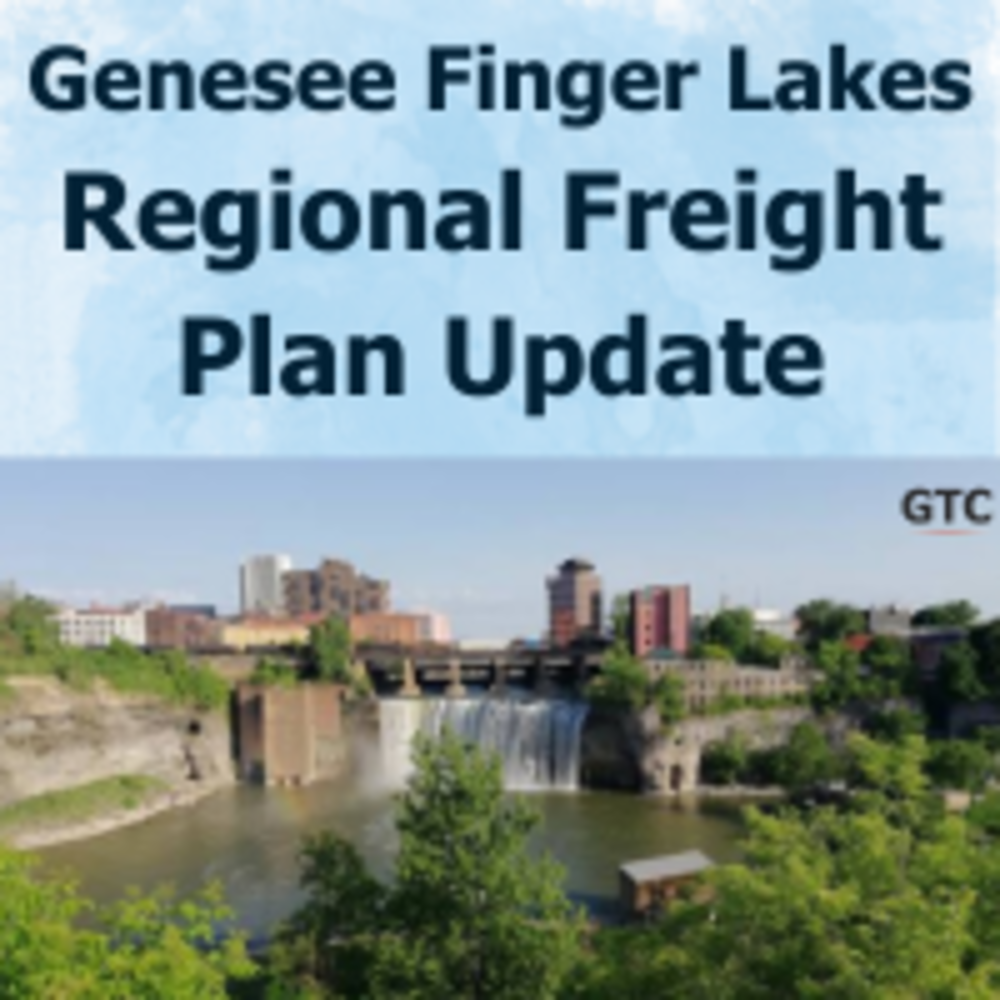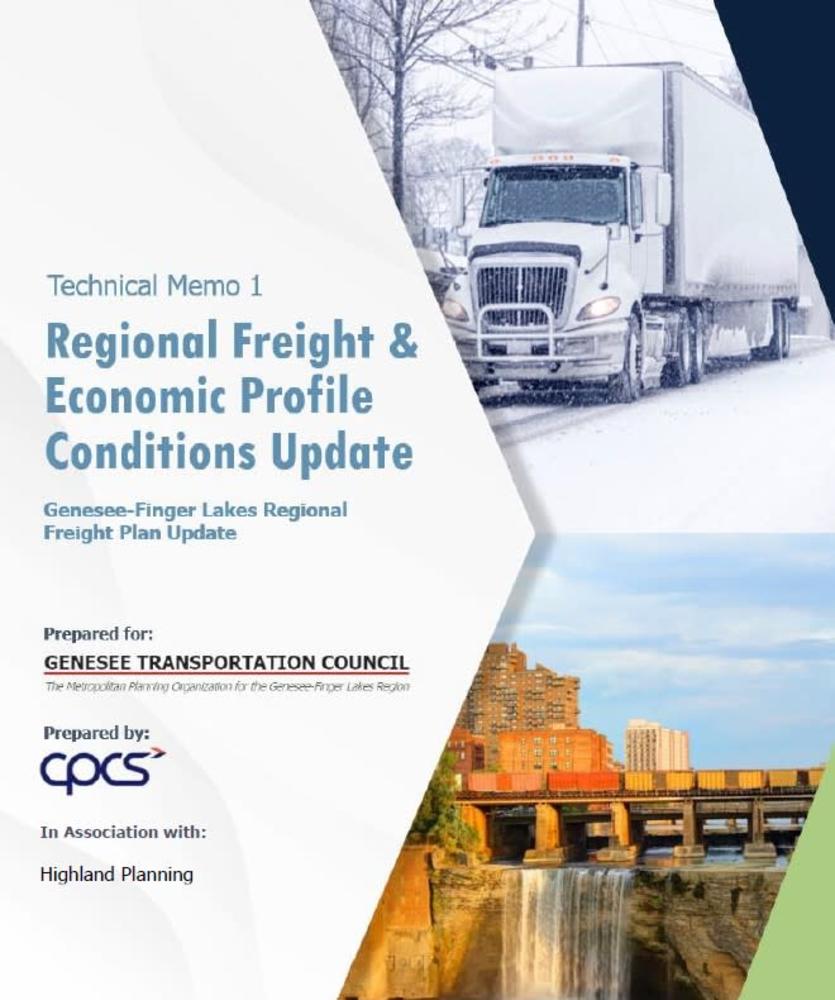Genesee-Finger Lakes Regional Freight Plan Update
Genesee-Finger Lakes Regional Freight Plan Update
Genesee-Finger Lakes Regional Freight Plan is a comprehensive study aimed at improving freight transportation efficiency, safety, and economic competitiveness in the nine-county region. This initiative seeks to develop a strategic plan that will guide the region's freight transportation investments and policies for the next 25 years. Visit the Project Outreach page at instantinput.com
GTC presented a summary of the project to the Planning Committee on January 9, 2025. Here is a video excerpt from the meeting recording. It is roughtly 12 min. 30 sec long.
Contact us to request a written transcript.
This project was also presented and accepted at the GTC Board Meeting on February 27, 2025.
Text version: Why Conduct a Regional Freight Plan?
GTC recognizes the importance of freight movement for economic vitality.
Position the region to successfully compete for federal and state discretionary funding
Transportation is not a limiting factor
Goods movement is crucial to the Genesee-Finger Lakes Region's economy and quality of life.
Millions of tons of goods move through this system annually.
Businesses that rely on the freight system supply jobs for over 30% of the regional workforce and nearly a quarter of regional economic output.
Transportation Planning Project Description
Objective
The purpose of this project is to update the 2012 Transportation Strategies for Freight and Goods Movement in the Genesee-Finger Lakes Region. The Freight Plan Update will explore the changes that have taken place over the past decade in the context of goods movement regarding the economy, consumer demand and expectations surrounding e-commerce, physical improvements to the freight transportation network, supply chain disruptions, workforce development opportunities, and emerging technologies including connected, autonomous and automated vehicles. Additionally, the Update will consider new opportunities and requirements from the most recent federal surface transportation reauthorization bill, the Infrastructure Investment and Jobs Act (IIJA)/ Bipartisan Infrastructure Law (BIL).
Background
The 2012 Regional Goods Movement Strategy was the first fully comprehensive regional freight plan to be conducted for the nine-county Genesee-Finger Lakes Region. Over the past decade, the freight industry has been undergoing a transformation. The economy has continued to move towards just in time delivery with little redundancy. In 2010 e-commerce sales made up less than 5% of total retail sales. In 2021 e-commerce sales made up about 14% of total retail sales. In 2016, the first commercial delivery using a self-driving truck was completed in Colorado, carrying 2,000 cases of beer 120 miles without any human assistance. Hours of service rules along with narrow delivery windows are squeezing the trucking industry’s already tight margins. The shipping and logistics industries are still reeling from the impacts of the COVID-19 pandemic. Rapidly changing technology and increased consumer demand has transformed the way goods are delivered.
Since 2012, GTC has funded several standalone freight plans that advance policies in the Goods Movement Strategy, including the Ontario County Freight Corridor Development Plan, the Ontario Midland Strategic Plan, and the Beh Industrial Park Traffic Optimization Study. Monroe County is beginning the Multimodal Freight Initiative Planning Project. While these plans and studies address local concerns within a broader regional context, they do not address the regional freight network in a holistic manner within the context of the state and federal policy directives, technology disruptions, and global economic trends.
Additionally, two major infrastructure improvement recommendations made in the 2012 Strategy have been implemented, the I-390/I-490/Lyell Ave Interchange reconstruction project and the replacement of the Portage Bridge on the Norfolk Southern railroad line. A new study is needed to identify potential future improvements.
Since the 2012 Strategy was adopted, there have been multiple updates to the federal transportation legislation. In recognition of the role freight transportation plays in spurring and sustaining economic development, the Moving Ahead for Progress in the 21 Century (MAP-21) legislation, for the first time, enacted a national freight policy. This policy includes multiple freight provisions to enhance the capability of the United States to compete competitively in the global economy. The Fixing America’s Surface Transportation (FAST) Act expanded the freight directives set forth in MAP-21. The FAST Act established a National Multimodal Freight Policy and called for the development of a National Freight Strategic Plan (released on September 3, 2020). Additionally, several new funding sources for freight-specific infrastructure improvements were created. Per the guidance of MAP-21, the New York State Department of Transportation (NYSDOT) completed the first state freight plan in August 2019. NYSDOT has initiated the process of updating of the state freight plan to comply with the IIJA/BIL. The IIJA/BIL continues to support the National Highway Freight Program and funding for freight infrastructure projects.
Manufacturing and agriculture are both primary sectors of the regional economy which heavily depend on freight infrastructure and industry to function. A primary objective of the 2012 Strategy was to develop goods movement strategies that will position the regional transportation system as a distinguishing factor in retaining and attracting both traditional and emerging-technology manufacturing firms, as well as enhancing the viability of agriculture. This objective will be continued with the Update. The Update will also explore opportunities in workforce development in the freight sector. The needs of the freight sector are changing and skilled workers in the logistics and manufacturing industries are needed, while the trucking industry's workforce is aging and lacks qualified drivers.
Steering Committe and Project Team
A committee of stakeholders will oversee the project development process. It will include representatives from the following entities: Genesee Transportation Council, New York State Department of Transportation; New York State Thruway Authority, Empire State Development Corporation, Genesee-Finger Lakes Regional Planning Council, the Monroe County Department of Transportation, City of Rochester, County Planning Departments/Industrial Development Agencies, private sector freight and logistics interests, chambers of commerce in the region, and other interested parties that are deemed relevant.
GTC has contracted with the consultant team of CPCS Transcom, Inc. a consultant with experience in regional freight planning, to lead the project development and Highland Planning, a consultant who specializes in community outreach to perform the following tasks:
- Develop a Regional Freight and Economic Profile [Existing and Future Conditions Inventory] by updating and/or confirming the Regional Freight and Economic Profile as presented in the 2012 Strategy.
- Update the key trends and issues regarding population and employment.
- Reassess the identified regional freight network by mode for truck, rail, air, and water.
- Inventory existing truck parking facilities.
- Update the Freight Flows by mode for truck, rail, air, water
- Evaluate the existing volumes of goods movement by directional flow (i.e., inbound, outbound, intraregional, and through) and commodity. These estimated current flows should be assigned to major freight corridors by mode for truck and rail.
- Project future freight related demand, capacity, and transportation network operating by directional flow (i.e., inbound, outbound, intraregional, and through) and commodity with a horizon year of 2050. Projected future flows should be assigned to major freight corridors by mode for truck and rail. These projections out to 2050 will be used by GTC staff as part of the next Long Range Transportation Plan.
- TRANSEARCH, Replica, and Freight Analysis Framework 5 (FAF5) data will be available to the preferred consultant for compiling existing and projecting freight demand and movement.
- Conduct a Strengths, Weaknesses, Opportunities, and Threats (SWOT) Analysis. Update the SWOT analysis that was completed for the 2012 Strategy. Each component of the SWOT analysis (i.e., Strengths, Weakness, Opportunities, and Threats) will be subdivided into three categories: 1. Institutional and Regulatory; 2. Infrastructure; and 3. Operational. Topics to explore during the SWOT analysis shall include, but are not limited to:
- Bottlenecks
- Recurring and non-recurring congestion
- Low clearance bridges
- Weight restricted facilities
- Truck parking
- Connected, autonomous, and automated vehicles
- E-commerce
- Workforce development/labor shortages
- Availability of shovel ready sites
- Regulatory measures at the state and federal levels (e.g., permitting oversize/overweight vehicles, hours of service, etc.)
- Conduct a Needs Assessment based on the updated SWOT analysis and data collected as part of the Regional Freight and Economic Profile, identify new freight transportation needs and reevaluate the needs identified in the 2012 Strategy. The results of the needs assessment will align with the five recommendation groups identified in the Long Range Transportation Plan 2045 (LRTP 2045) as they relate to goods movement:
- Health and Safety
- Access and Equity
- System Management and Maintenance
- Sustainability and Resilience
- Economic Development
- Develop Recommendations by analyzing the relevancy of recommendations in the 2012 Strategy and identify revisions to ensure continued applicability and develop new recommendations based on the results of the SWOT analysis and Needs Assessment.
The 2012 Regional Freight Strategy Plan listed 35 Near-Term, Medium-Term and, Long-Term Recommendations. The Update will reassess and revise these recommendations to ensure their continued relevance for the region. Anticipated recommendations include suggested capital projects, planning project concepts that warrant further study via the Unified Planning Work Program (UPWP), transportation system management and operation (TSMO) initiatives, general policy directives, safety improvements, e-commerce implications (e.g., curb management strategies), zoning regulations and traffic considerations when sighting warehousing/distribution sites, resiliency concerning freight facilities, and opportunities for work force enhancement and development.
- Develop an Implementation Plan for the recommendations developed. The implementation plan will identify local, regional, state, and federal funding opportunities for each recommendation. All recommendations will be sub-divided into Near-term, Medium-Term, and Long-Term recommendations and will be evaluated and prioritized.
- Develop a Regional Freight Plan Update consisting of recommendations and the implementation plan.
Visit the Project Website to Learn More and Participate
Planning Study Summary
The study will involve a thorough analysis of the current state of the region's freight network, including an assessment of infrastructure, traffic patterns, and economic trends. The project team will work closely with stakeholders from both the public and private sectors to identify challenges, opportunities, and potential solutions to enhance the movement of goods across the region.
Key objectives of the Genesee-Finger Lakes Regional Freight Plan include:
- Developing an updated profile of the regional freight network and economic conditions
- Identifying current and future needs and issues impacting efficient freight movement
- Conducting a Strengths, Weaknesses, Opportunities, and Threats (SWOT) analysis of the freight system
- Formulating recommendations for projects, initiatives, and policies to improve freight efficiency and support economic growth
- Creating an implementation plan to prioritize and fund the recommended actions
The Genesee-Finger Lakes Regional Freight Plan is expected to be completed by December 31, 2024. The resulting Plan will serve as a roadmap for the region's freight transportation system, helping to support economic vitality, enhance quality of life, and position the Genesee-Finger Lakes region for long-term success.
For more information about the Genesee-Finger Lakes Regional Freight Plan and upcoming opportunities to get involved, please visit instantinput.com or contact the Jody Binnix, AICP Deputy Director of Planning Genesee Transportation Council at JBinnix@gtcmpo.org.
Technical Memo 1
Regional Freight & Economic Profile Conditions Update
Link to PDF Document




